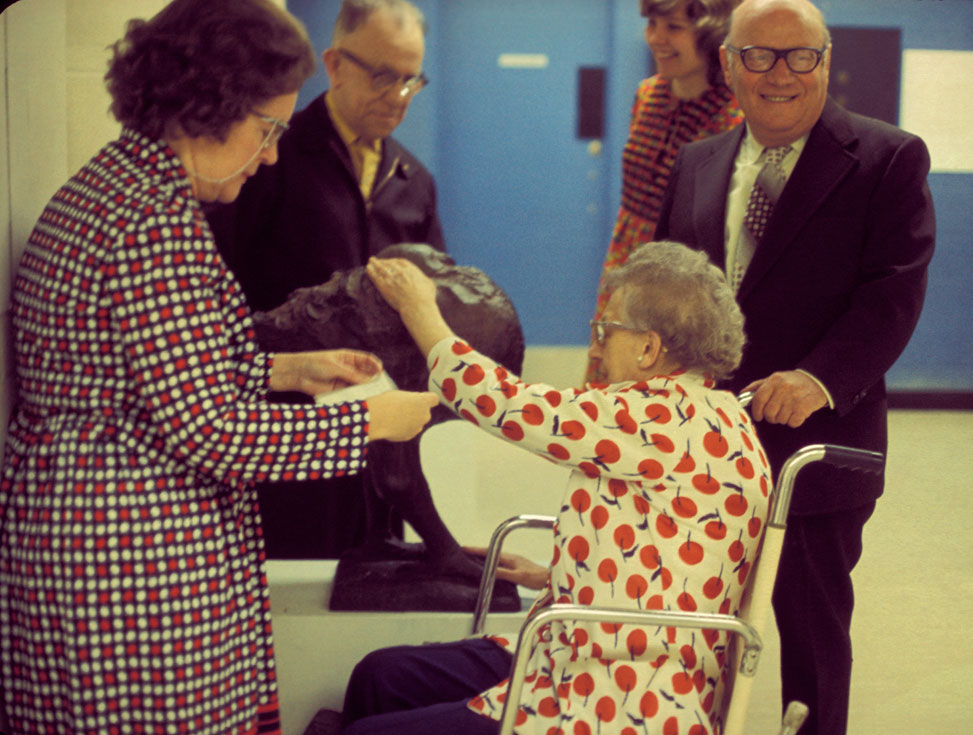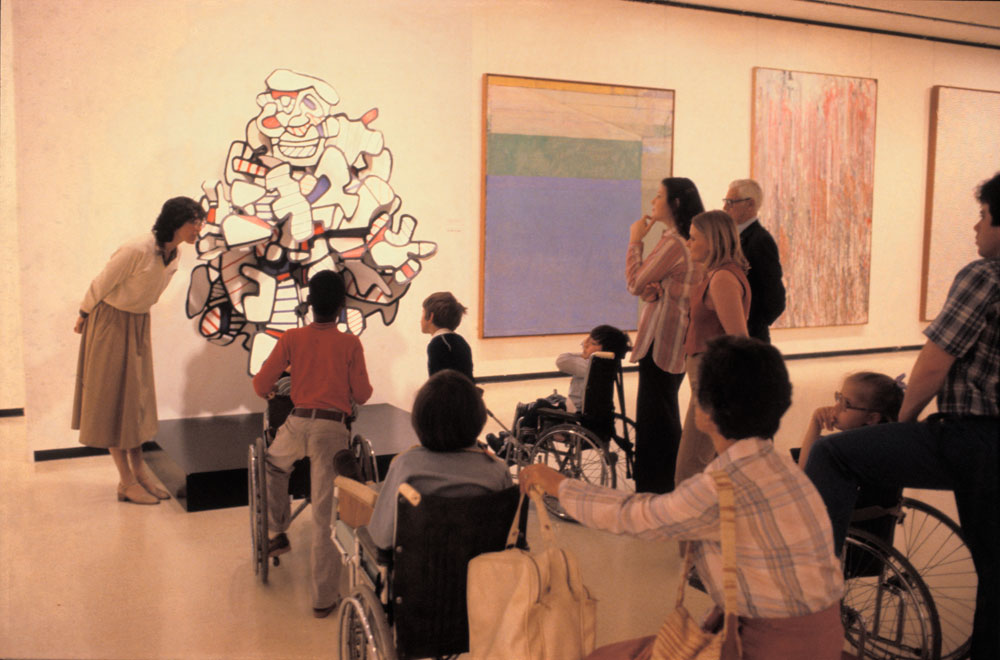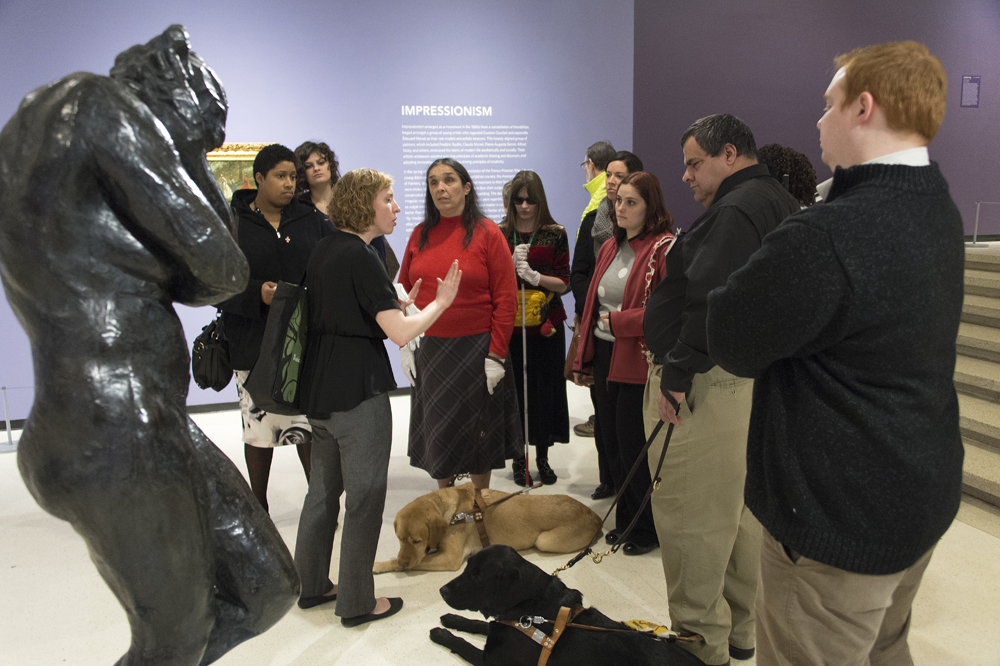History of Accessible Programing
The Buffalo AKG Art Museum was one of the first major museums in the United States to make a commitment to welcome groups with special needs. At the heart of that effort was the Matter at Hand program, which started on a small scale in 1973 with programs for visitors who are blind and visually impaired, and has since expanded considerably in the types of audiences it serves. “To the Heart of the Matter through the Hand of Man” was the original concept and guiding philosophy for Matter at Hand, which grew out of the conviction that individuals with disabilities, for whom quality museum experiences had been largely inaccessible, have a right to the same opportunities as anyone else.

The program began in 1973 with an exhibition of touchable sculpture accompanied by workshops in clay designed for individuals who are blind or visually impaired. The program ran for four weeks and was made possible, in large part, by the efforts of 55 Junior Group volunteers and museum docents who served as guides and classroom assistants. The Junior Group also funded two trained instructors, the necessary art supplies, and exhibition materials.
Matter at Hand II, presented in 1975, followed the same format—an exhibition of touchable sculpture combined with hands-on workshops—but offered a wider variety of media. Once again, the Junior Group funded the volunteer-run program. Matter at Hand was extended further into the community with the participation of the Buffalo and Erie County Historical Society (now the Buffalo History Museum) and the Buffalo Museum of Science, which offered programs in the contexts of their collections. The Historical Society explored costumes and tools, and the Museum of Science made its nature trail accessible through specially guided tours.
In 1976, a series of creative workshops was offered, funded by the National Endowment for the Arts and the museum’s Members’ Council, another volunteer group. In six two-hour sessions, groups toured the museum and participated in studio workshops featuring a variety of media. This became the format for Matter at Hand III, presented in 1977, made possible with funding and volunteers from the Junior League of Buffalo, as well as additional support from the Crippled Children’s Guild, which provided transportation costs; and the Buffalo Real Estate Board, which funded the presentation of the documentary I Am Not Blind, produced by Les Levine for the Wadsworth Atheneum in Hartford, Connecticut. Continuing with Matter at Hand IV in 1979, the program relied heavily on funding from outside sources and on volunteer assistance, including 30 of the museum's docents, who conducted tours for participants.

In the spring of 1980, Matter at Hand V explored a new direction. The program was the result of a collaboration between the museum and the Theatre of Youth (TOY), a local theatre company. Michael through the Painting, a play by Henry Kautz, was commissioned and presented to children in conjunction with a series of one-hour creative drama classes. Stressing creative drama as a teaching tool to enhance museum learning, the program provided an introduction to the Albright-Knox, the concept of a museum, and the basic art elements of color and line.
For its first eight years of existence, the Matter at Hand program was largely volunteer- staffed and available for only a few weeks each year. In the fall of 1981, an endowment for the program set up by the James H. Cummings Foundation made possible the hiring of a professional coordinator/instructor and the development of an overall program budget. This transformed Matter at Hand into one of the regular, ongoing programs of the Albright-Knox’s Education Department. The budget was supplemented with additional funding from the Aetna Life and Casualty Foundation; Fisher-Price Toys, Inc.; and the Mobil Foundation, Inc.
With this increased and sustained support, Matter at Hand expanded beyond the community of people who are blind and visually impaired to serve individuals with a wide variety of special needs, including individuals with speech and hearing impairments, developmental delay, and physical and emotional disabilities, as well as psychiatric and geriatric populations. The program’s coordinator, in a series of related sessions, visited the groups’ home sites and provided museum tours and workshops. The museum also presented exhibitions of the artwork produced by program participants, accompanied by opening receptions, three times each year in the Education Department. In 1993, the Matter at Hand program and its coordinator, Lisa Garvey, received a Certificate of Merit from the State of New York “in recognition of dedicated service to children with disabilities and their families.”

Matter at Hand continued to serve the special needs populations of Western New York, with the James H. Cummings Foundation endowment continuing to be a major source for the program’s operating support. The Eileen and Rupert Warren Charitable Fund of the Community Foundation for Greater Buffalo has also been a long, loyal, and generous supporter of Matter at Hand. Funding each year is supplemented with grants from a variety of local businesses, individuals, and corporations, which over the years have included Clement and Karen Arrison; Conax Corporation; General Mills, Inc.; HSBC—North America; the Institute of Museum and Library Services; the LTN Foundation/Sierra Research Division; Rite Aid Pharmacies; and Starks Associates, Inc.
In 2012, the museum adopted the umbrella term Access AK to encompass the many dynamic accessible programs and services being offered at the museum, including Creative Connection, the new name for Matter at Hand. Access AK is made possible today through the generous support of the James H. Cummings Foundation, Inc. Endowment; The William M. Wood Foundation; an anonymous donor; and National Fuel.